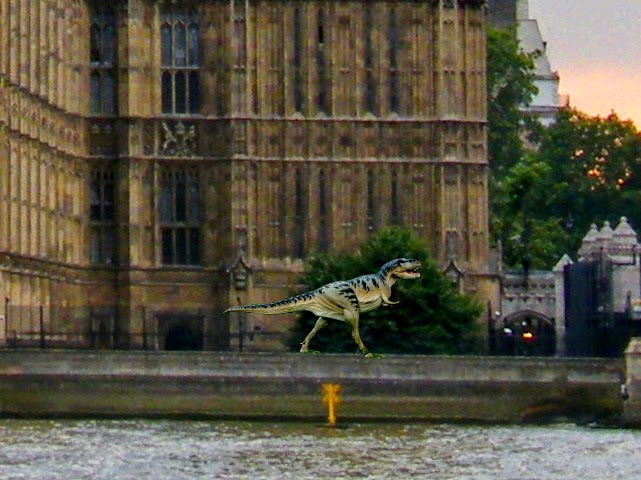I enjoyed it! I found the story was mostly forgettable, but that’s normal for a new Doctor’s introduction, where the focus is very definitely on the character. (Doctor Who is a series with a mild, recurring case of pilotitis) The real joy was watching Capaldi’s interpretation of this much-beloved character. Anyway, I digress.
One thing bothered me, though: the size of the Tyrannosaurus. I had no real idea of how big the clock tower of Westminster Palace (popularly, though inaccurately known as “Big Ben”) is, but I knew it had to be much bigger than it appears to be beside the Tyrannosaurus stomping around beside it. When I got home, I looked it up, and the tower is quite huge—96 metres high!
Yet shots like these make it clear that the dinosaur is meant to be very nearly as tall as the clock tower, and the multiple angles and directions confirm that this is not just a trick of perspective, but that this is the intended size:
Now, an adult Tyrannosaurus was only about 4 metres tall at the hip, so really, to be in proper scale, it would have to look more like this:
Can’t see it? It’s just about almost as tall as the clump of greenery there at the base of the tower:
So really, a very very long way away from what was depicted on screen!
As a final note, the last time Doctor Who depicted a Tyrannosaurus loose in London was in 1974’s serial “Invasion of the Dinosaurs”. Here’s what it looked like back then:
There’s obviously no contest in realism here (or in accuracy—we know so much more about these animals now than we did forty years ago!)
However—and this is the important point—notice that the 1974 Tyrannosaurus is depicted around about the right size! If anything, it looks very slightly too small for an adult, maybe around 3 metres at the hip. So perhaps this one was a juvenile?
All images from Doctor Who are copyright BBC. I assert that my use here is fair dealing for the purposes of criticism and review.
My composite images of the correctly-scaled Tyrannosaurus against the clock tower are made from an image of the clock tower by Adriano Aurelio (via Wikimedia Commons under a Creative Commons CC-BY 2.0 licence) and an image of a model Tyrannosaurus by User Pibwl (via Wikimedia Commons under a CC-BY-SA 3.0 licence). I release this composite image under a CC-BY-SA 3.0 licence.







They never actually mention the species, and they address the size right at the start:
ReplyDeleteJenny: "Big fella, isn't he".
Vastra: "Dinosaurs were mostly this size, I do believe it's a she".
Jenny: "No they weren't, I've seen fossils".
Vastra: "I was there"
You're right that the species isn't named on-screen, but I don't think that's a big deal. If the show presents us with an ostrich, we don't need a character to say "Wow! Look at that ostrich!" to know what we're looking at. But, if we're generous and assume that this isn't a Tyrannosaurus, now we have the problem of an animal built and proportioned just the same way as a much smaller creature, although it's 20 times the size and therefore 8,000 times the mass.
DeleteTo me, lampshading that in dialogue doesn't make the problem go away any more than it would make a 100-metre-tall ostrich more credible! :)
The doctor calls it a "giant dinosaur" so its obviously not meant to be an ordinary dinosaur
ReplyDeleteI'm willing to chalk it up to Silurian generic engineering. Hard to imagine a species this large existing in the wild. It'd wipe out entire ecosystems.
ReplyDelete